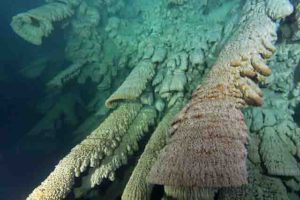
In recent years, researchers have identified a small group of stalactites that appear to have calcified underwater instead of in a dry cave. The Hells Bells in the El Zapote cave near Puerto Morelos on the Yucatán Peninsula are just such formations. A German-Mexican research team led by Prof. Dr Wolfgang Stinnesbeck from the Institute of Earth Sciences at Heidelberg University recently investigated how these bell-shaped, metre-long formations developed, assisted by bacteria and algae. The results of their research have been published in the journal Palaeogeography, Palaeoclimatology, Palaeoecology.
Hanging speleothems, also called stalactites, result through physicochemical processes in which water high in calcium carbonate dries up. Normally they rejuvenate and form a tip at the lower end from which the drops of water fall to the cave floor. The formations in the El Zapote cave, which are up to two metres long, expand conically downward and are hollow with round, elliptical or horseshoe-shaped cross-sections. Not only are they unique in shape and size, but also their mode of growth, according to Prof. Stinnesbeck. They grow in a lightless environment near the base of a 30 m freshwater unit immediately above a zone of oxygen-depleted and sulfide-rich toxic saltwater. “The local diving community dubbed them Hells Bells, which we think is especially appropriate,” states Wolfgang Stinnesbeck. Uranium-thorium dating of the calcium carbonate verifies that these formations must have actually grown underwater, proving that the Hells Bells must have formed in ancient times. Even then the deep regions of the cave had already been submerged for thousands of years.
According to the Heidelberg geoscientist, this underwater world on the Yucatán Peninsula in Mexico represents an enigmatic ecosystem providing the conditions for the formation of the biggest underwater speleothems worldwide. Previously discovered speleothems of this type are much smaller and less conspicuous than the Hells Bells, adds Prof. Stinnesbeck. The researchers suspect that the growth of these hollow structures is tied to the specific physical and biochemical conditions near the halocline, the layer that separates the freshwater from the underlying saltwater. “Microbes involved in the nitrogen cycle, which are still active today, could have played a major role in calcite precipitation because of their ability to increase the pH,” explains Dr Stinnesbeck.
Reference:
Stinnesbeck, W., Frey, E., Zell, P., Avíles, J., Hering, F., Frank, N., Arps, J., Geenen, A., Gescher, J., Isenbeck-Schröter, M., Ritter, S., Stinnesbeck, S., Aceves Núñez, E., Fito Dahne, V., González González, A.H., Deininger, M. Hells Bells – unique speleothems from the Yucatán Peninsula, Mexico, generated under highly specific subaquatic conditions. Palaeogeography, Palaeoclimatology, Palaeoecology, 2017 DOI: 10.1016/j.palaeo.2017.10.01
Note: The above post is reprinted from materials provided by Heidelberg University.










